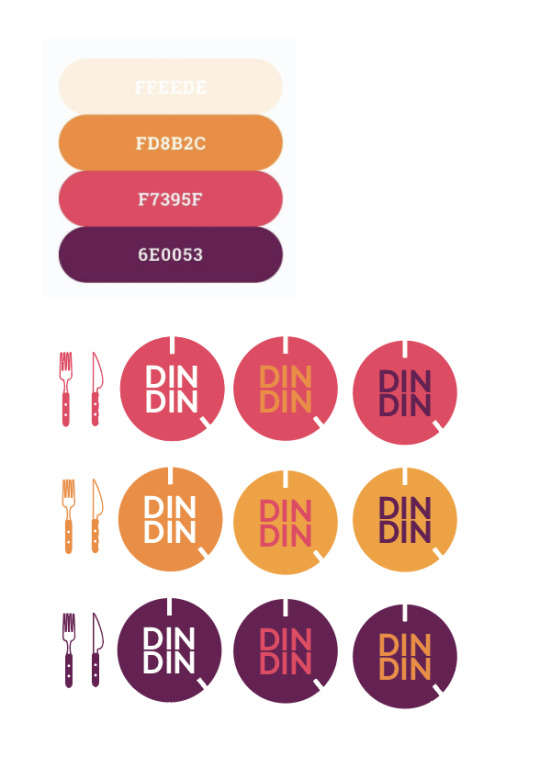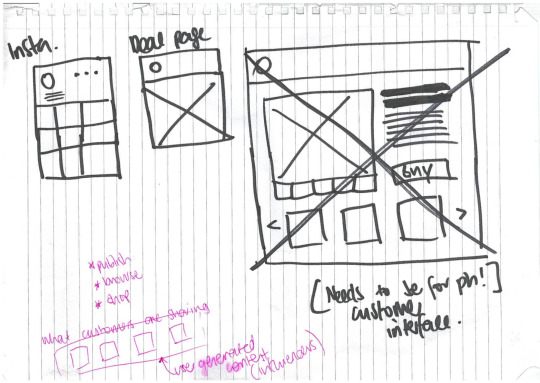Text
ITERATIONS
Following user testing, the following iterations would be made to the prototype:
Add more colour and visuals on pages following the homepage to make it more engaging with infographics or graphics in floating cutlery style.
Consider/test how to make editing things more obvious on deals/profile
Edit profile page layout
Add a ‘tips’ component on adding deals pages
Make customer interface look more ‘flash’ = worthwhile.
0 notes
Text
HI FIDELITY MOCK UP - BUSINESS

View here: https://www.figma.com/proto/XDFVLkoGV6gRIhEkOYmOyd4u/Dindin?node-id=0%3A1&scaling=min-zoom
0 notes
Text
USER TEST PLANS + RESULTS

*EDIT**** During my first user test with a business focused user, I realised I was missing a very important task: Task 3: Can you add a deal for Chur-O.
I used the above user test plan to test with two users from each stakeholder group.
RESULTS
Customer:
Business:
Home ----> User dash (deals)
Participant B1 really liked the instagram preview on the first page, found it engaging and excited them to participate. Thought the design was funky and fun, however thought that the user dash wasn’t as cool as the other pages. They suggested it needed more visuals like the fork graphic on the previous pages. When viewing the deals, participant B2 was confused that it functioned as multiple clickable frames, so exited without seeing the whole part of what the customer sees (profile and redeem). Participant B1 thought it wasn’t as engaging, “looks like an app freebie, not flash”
Deals ----> Profile
Participant B1 stated they would click on the edit icon to make any changes to their profile, however participant B2 wanted to click on the test itself. Participant B1 asked whether they could change the user icon to their own logo.
Profile ----> Analytics
Participant B1 thought this was the best page they had seen so far with a variety of colour used describing it as “clear cut, showing exactly what has happened”.
Adding a new deal:
Both participant B1 & B2 found the process of adding a new deal straightforward and easily understandable. Participant B1 liked the chronological order but wanted more tips on how to get the most out of the post i.e. examples of tags to use, favourite tags or ‘we recommend 5 - 10 tags’ because some people add so many. When asked how they saw that on the current userface i.e. as a caption or help button they liked the idea of a ‘?’ icon or link saying ‘need tips?’
“Would your business use this app service”
Participant B1′s business already uses third part deals all the time and said they would definitely use a DINDIN type service. Participant B2 said they felt it would be a beneficial add on to the business as it is currently demonstrated but would need to prove value:effort in practice.
“Where do you see its value?” Participant B1 spoke of how, once you are an already established business, its hard to build new engagement on social media because you’re not ‘new’ or ‘exciting’ and sponsored posts are expensive in order to get anything out of it. Participant B2 values the power of social media and using this to create brand awareness.
0 notes
Text
PROTOTYPING - CUSTOMER EXPERIENCE

View here:
https://www.figma.com/proto/HjPLRRAOIfJcOUNAE0LJqL26/instagram-ui-kit-kerroudj-2?node-id=0%3A1&scaling=min-zoom
0 notes
Text
TRIADING - KEY TAKEAWAYS

Tripadvisor - a good source of information thats helpful to make a decision
Grabone - cheapens brands, undervaluing what you do + uneven playing field. They win, customer wins.
Instagram - free platform, “how do you survive without it”
Entertainment book - good inbetween to encourage people to try something different and spend their own money, bit out of date andhavent seen it for years
Zomato - “like rotton tomato for movies but for food”, difficult to use on mobile repeated prompts to download app
0 notes
Text
SECONDARY RESEARCH - DEALS SERVICE PERCEPTION STUDY
Dholakia, U., Kimes, S. & Wu, J. (December, 2012). Restaurant Daily Deals: The Operator Experience Retrieved from: https://scholarship.sha.cornell.edu/chrpubs/168/
Advantages and Disadvantages of Daily Deals
“To say that daily deals are controversial is an understatement. On the one hand, daily deals have been said to create new customers, increase revenue and profit, and provide greater exposure for restaurants. On the other hand, restaurant operators have expressed concern about the cost of daily deal promotions, cannibalization of existing, full-paying customers, the potential displacement of full-paying customers during busy periods, and the consequences of daily deals customers’ poor tipping behaviour on employee morale.”
Stats on the purchasers:
“Approx one-third (31%) of the respondents had purchased a daily deal from a restaurant. We found that daily deal purchasers tended to be younger, be married, have a higher income, and live in an urban or suburban area. About half (47%) of the daily deals purchased were for casual restaurants with another third (32%) for quick-service or fast-casual restaurants. Only 22 percent of respondents said that they were new customers at the restaurant in question. About 44 percent of respondents were already frequent customers and the remaining 34 percent had been to the restaurant before but did not consider themselves to be regulars. Customers were pleased with their daily deal experiences”
Deal structure.
“The value of most deals was under $50 (70%), and on average customers paid about half (49%) of the deal value.”
“Operators shared an average of 40 percent of revenue obtained from coupon sales with the daily deal promoter.”
"Typically, customers had less than six months to redeem their purchased coupon.”
“Daily deal experience. Respondents reported that about 40 percent of the daily deal users were new customers, and that 35 percent of them returned to the restaurant without a promotion.”
“About 38 percent of respondents reported that they made money on the promotion and a similar percentage (39%) stated that they lost money. The remaining 23 percent stated that they broke even on the promotion”
Why No deals? “We asked the respondents who had never offered a daily deal why they had not done so. The top four reasons given were that daily deals were not profitable (61%), that daily deals attracted the wrong type of customers (46%), that they would lose money (46%), and that daily deals were bad for the restaurant’s image (44%).”
0 notes
Text
SECONDARY RESEARCH - ECOMMERCE AND SOCIAL COMMERCE
Already well utilised by businesses in retail and proven effective - how could the hospitality business expand
Boateng, R., Budu, J. & Entee, E. (2018) Preliminary Insights into Social Commerce Capability Development. MWAIS 2018 Proceedings. 30. Retrieved from: https://aisel.aisnet.org/cgi/viewcontent.cgi?article=1029&context=mwais2018
"Social commerce refers to any commercial application based on the Internet which supports social interaction and user content generation through social media in order to support individuals in their purchasing decisions”
Matthews, T. (April, 2018). What is Social Commerce? And Examples of Campaigns. Retrieved from: https://www.fourthsource.com/social-media/what-is-social-commerce-and-examples-of-campaigns-22698
“74% of consumers depend on social networks to help them make purchasing decisions”
“Shopping in person has always been a social experience, with consumers asking friends or family for recommendations and people going shopping together to pass the time. eCommerce, on the other hand, is inherently the opposite of social. As technology has evolved and businesses have found ways to add a more social aspect to buying online, social commerce has really taken off.”
"A study from Shopify shows that Instagram has the highest order value on average among the “big four” sites for social commerce"
“Social media has grown in popularity with the rise of smartphone use, and it only makes sense for businesses to target customers right where they happen to be – whether it’s inside Facebook. Twitter, or another social media platform.”
Abbamonte, K. (July, 2018). Social Commerce For Retail: What Is It and 3 Examples of Retailers Doing it Well. Retrieved from: https://www.shopify.com/retail/social-commerce-for-retail-what-is-it-and-examples-of-retailers-doing-it-well
“According to Adweek, the top 500 retailers brought in nearly $6.5 billion from social shopping in 2017.”
“Social commerce, or social shopping, is the inevitable meeting point of social media and commerce. It’s a way to streamline the buying process for customers and increase the efficacy of social media ads for brands.”
“30% of consumers now saying they’d make a purchase on major social platforms like Pinterest, Instagram, Twitter, or Snapchat. That makes it a really good time for your retail business to get in on the action.”
“One of the first and most popular ways to transform social media into a sales channel is the “buy now” button. You can find one of these on most of the big social networks including Facebook, Twitter, Instagram, and Pinterest.”

Koss, M. (January, 2018) The 3 Social Commerce Trends To Master This Year. Retrieved from: https://www.yotpo.com/blog/the-4-most-powerful-social-commerce-trends/
“The customer’s word is the strongest word in online marketing today. So naturally, mastering social commerce in 2018 will be all about creating a more engaging online shopping experienceon social using your customer voice.”
“Social channels were designed originally for interaction, expression, and, most importantly, to create connections. Today’s most successful eCommerce brands are not seeking just to grab attention on social, but to join the conversation.”
“With Instagram scaling to 800 million users at the end of 2017, it’s clear your customers have turned their attention to visual content.”
0 notes
Text
USER FLOW/FEATURES



This userflow illustrates an MVP for the business portal. Deals - Queue, view edit, repurpose, see metrics of all deals. Profile - Created for the customer, a business snapshot - where, who, what in 5secs. Analytics - Audience stats, who they are and where they are coming from and when, what they follow/like/tags so that the business is able to better entice certain audiences and when are the best times/days to post deals.

This userflow illustrates multiple interactions and touch points via the instagram platform. It’s purpose would be ‘Introductory’ for each brand. Activity metrics here are valid as is the nature of hospitality, not all conversions will be able to be measured online as it is an *instore* experience. The most important thing to see if the reach your posts are getting i.e. brand awareness.
0 notes
Text
BRANDING DRAFT






Imagery to only be used inside instagram boxes... otherwise use graphic elements or colour blocking as above. Decide on when to use colours + colours for logo.
0 notes
Text
WORKING WIREFRAMES



These wireframes were used to build the MVP.
0 notes
Video
A low fidelity, clickable prototype made on marvel to get a quick feel of how many screens might be needed and how it might work for an MVP.
0 notes
Text
PRIORITIZING: MVP
DINDINs endeavors to be a one-stop-shop for businesses to generate deals utilising instagram as a social commerce platform to create brand awareness and reach new audiences.
The minimum viable product should include the following for the business:
Information about the service and how it works (onboarding)
Ability to log in/sign up to an account
A simplified and intuitive process to add deals that allows brand control
Ability to track deal metrics provided via instagram i.e, click rate, reach, conversion.
The minimum viable product should include the following for the customer:
To access relevant information about deals on offer and the restaurant itself i.e. location, menu
0 notes
Text
SECONDARY RESEARCH: INSTAGRAM ANALYTICS
https://adespresso.com/blog/instagram-analytics-guide/
How could this work for my service?
Instagram has built-in analytics, my service could take these directly from instagram and integrate them into the platform on the business side. I believe this to be an important component, making DINDIN a one-stop-shop for business owners to get quantitive data and measurable results.






0 notes
Text
Branding Scribbles


Here I decided on the name: DINDIN
0 notes
Text
HMW questions - business

These ‘HMW’ questions were formed following infinity diagramming. I was then able to narrow it down to the following in order to construct an MVP

And it should do these things, according to interviews illustrating the needs of the businesses.

0 notes



